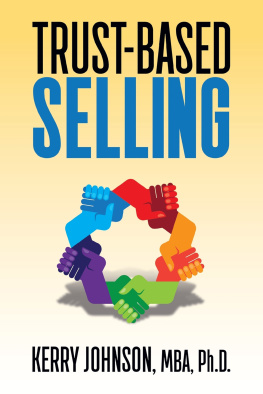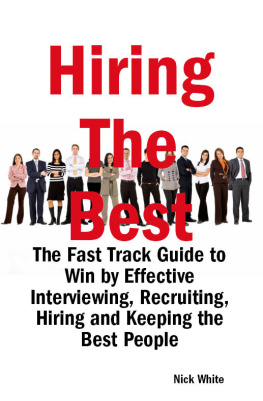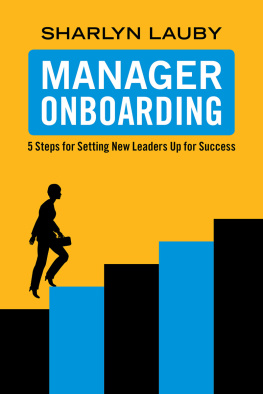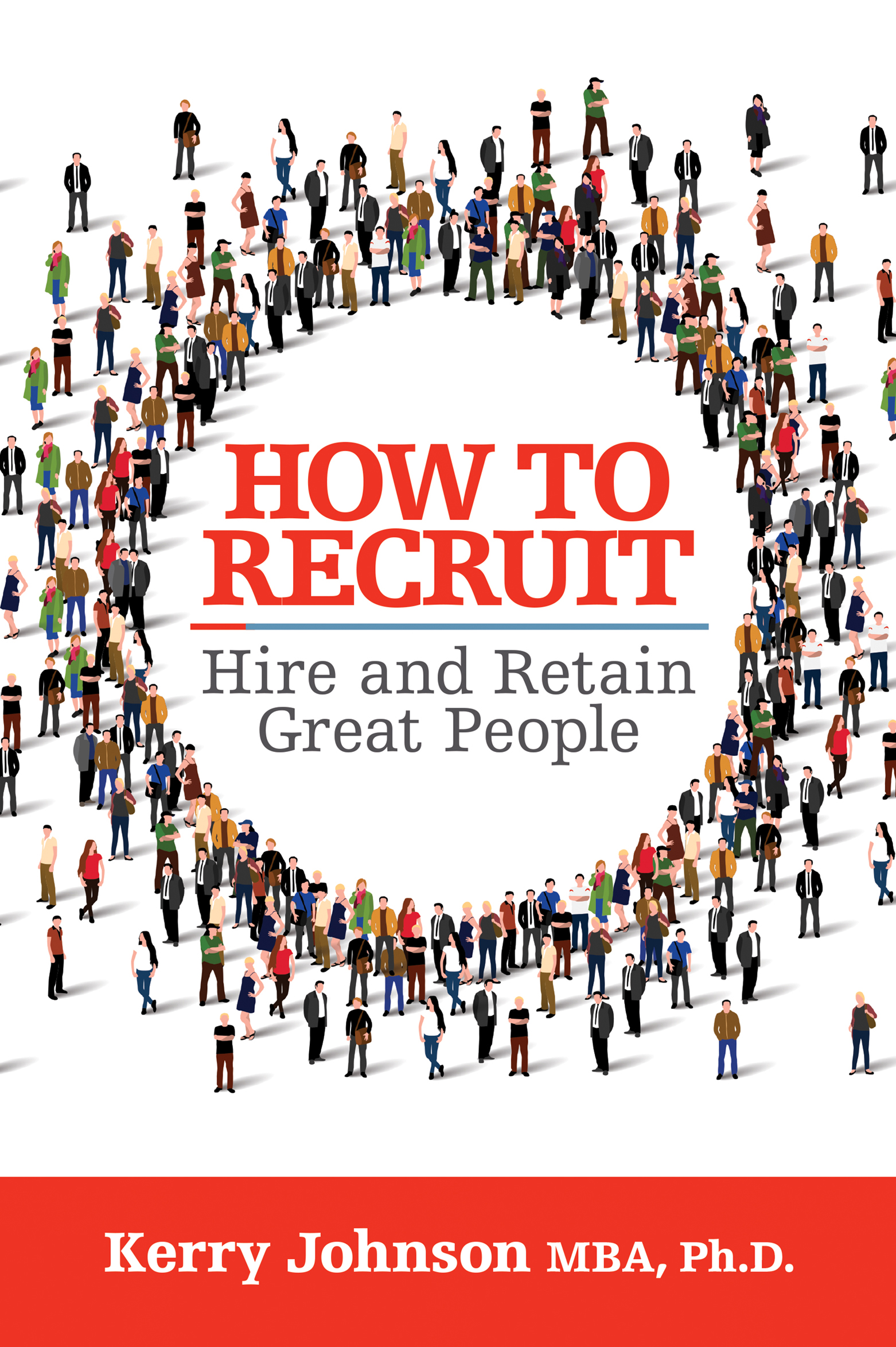Contents
Guide
Pagebreaks of the Print Version
Also by Kerry Johnson
New Mindset, New Results
Why Smart People Make Dumb Mistakes With Their Money
Willpower
Mastering Self-Confidence with NLP
Phone Sales
Sales Magic
How to Read Your Clients Mind
Peak Performance
Trust-Based Selling
The Referral Mindset
Mastering the Virtual Sale
Negotiating the Deal
HOW TO RECRUIT

Hire and Retain Great People
Kerry Johnson MBA, Ph.D.


Published 2022 by Gildan Media LLC
aka G&D Media
www.GandDmedia.com
HOW TO RECRUIT. Copyright 2022 by Kerry Johnson. All rights reserved.
No part of this book may be used, reproduced or transmitted in any manner whatsoever, by any means (electronic, photocopying, recording, or otherwise), without the prior written permission of the author, except in the case of brief quotations embodied in critical articles and reviews. No liability is assumed with respect to the use of the information contained within. Although every precaution has been taken, the author and publisher assume no liability for errors or omissions. Neither is any liability assumed for damages resulting from the use of the information contained herein.
FIRST EDITION 2022
Front cover design by David Rheinhardt of Pyrographx
Interior design by Meghan Day Healey of Story Horse, LLC
Library of Congress Cataloging-in-Publication Data is available upon request
eISBN: 978-1-7225-2274-2
10 9 8 7 6 5 4 3 2 1
Contents
Introduction
Have you ever hired someone who didnt work out? Ever spend months interviewing candidates and at the end just guessed at whom to pick? And the worst: have you ever spent weeks interviewing and still couldnt find the right person? You are probably like a lot of leaders I work with, who want to pick the right people without spending a lot of time searching.
A good economy means a lower unemployment rate. With fewer people looking for jobs, getting good people is all the more difficult. In 2019, the unemployment rate went down to 3.5 percent across America. Certain states had even fewer job openings. In fact, it was so difficult to find good people that many employers found themselves in bidding wars to attract talent. The worst part is the desperation of not being able to grow your business because you cant find good people.
One financial advisor in Cleveland, Ohio, searched for an assistant for more than a year. He thought he found a good administrative candidate, a fellow Marine; they met at a military club. He recruited her from a job she was not enamored with. (We will discuss later why recruiting those already employed is the easiest and best way of hiring good candidates.) She worked effectively for about six months. But then decided to spend the rest of her preretirement as a volunteer. Now the financial advisor is back searching for another candidate.
A few years ago, the same advisor recruited a recent college graduate. He paid for licensing and even six months of training. The new hire lasted only six months past the training investment. Once again, the hire was a waste of time. If this Cleveland financial advisor knew what you are about to learn, he would have saved nearly three years of hiring mistakes. He would have been able to turn his focus to increasing sales instead of spinning his wheels recruiting staff.
The Great Resignation
During the pandemic of 2020, more than 22 million jobs were lost. But after the Covid Omicron variant, many of those who worked before the lockdowns across the United States decided to retire or resigna phenomenon labeled the Great Resignation. Two years after Covid induced massive job losses, more than 10.6 million jobs remained unfilled. Unemployment decreased from 14.8 percent during the pandemic to only 3.9 percent after. Every employer continues to struggle to find workers in a dwindling pool of available candidates. As late as December 2021, payrolls remained 3.6 million jobs shy of the high employment levels of February 2020.
Because of increased savings accumulated during Covid, many workers over the age of fifty-five decided to leave the workforce. Labor force participation had been decreasing 0.3 percent per year. But the decreasing amount of people willing to work dropped even more in 2022. In fact, 3.3 million people retired soon after 2020. The Federal Reserve reported that retirements included 2.4 million more people than expected based on demographics alone.
But there is worse news. According to a recent Stanford University study, 3 million of those already out of work between the ages of twenty and sixty-five will stay out of the workforce indefinitely. This is called long social distancing. These workers tend to be women, lack a college degree, and have worked in low-paying jobs. These workers have made changes in their employment outlook to accommodate a permanent departure from the workforce.
Emblematic of the trend toward either a delayed reentry into or permanent departure from the workforce is an orthopedic physician friend in his late sixties. Greg had a great practice for nearly forty years before Covid. Because of the lockdowns and the prohibition against elective surgeries, his practice stalled. Staff were in short supply for many weeks. He and his partners paid the salaries of those who remained for many months out of savings. This was unsustainable. Eventually, Greg decided that retirement was better than bleeding his IRA for business-related expenses. Greg would rather have continued his practice. He enjoyed his career. Instead, he became a statistic.
Many members of the Great Resignation between the ages of twenty-four and fifty-four will make their way back into the workforce as their savings dwindle. But it may take a few years. There are many reasons for this delay. Over 13 million households have young children. Many schools have been slow to reopen, forcing families to find expensive childcare or provide it themselves, causing them to stay out of the workforce.
The worst time of the stay-at-home trend was in January 2022, when 9 million people reported Covid illnesses. They unable to work anyplace and stayed home, even without symptoms. As many return to the workforce, they will turn to gig jobs as a stepping-stone to more formal work environments.
All of these are reasons for wage inflation and enhanced benefits as companies compete for very few workers. This has also caused a wage-feedback loop. As wages increase for scarce workers, companies increase prices. This inflation in turn diminishes wages, creating a demand for still higher pay. To make matters worse, birthrates have been decreasing, making the workforce of the future even smaller. To fill the gap, many companies engaged temporary and seasonal workers. But even this pool of workers proved hard to find as borders shut down.














